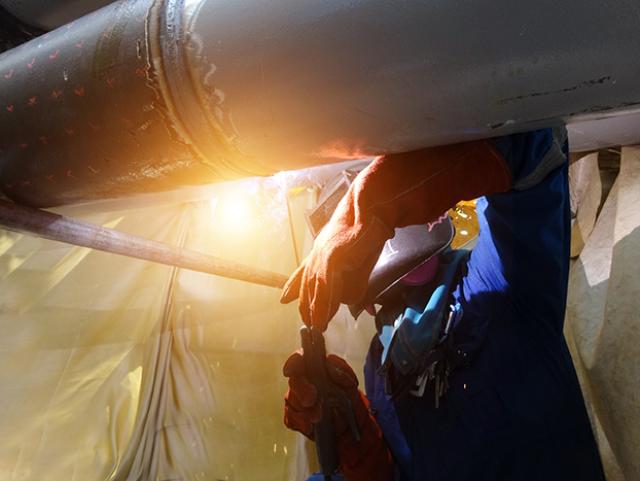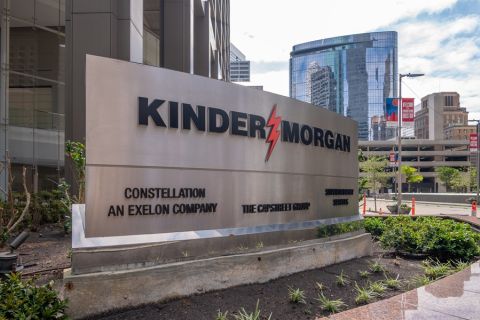
Editor’s note: This is the first of a three-part series exploring the role of technology in pipelines. Part one covers construction.
Technology has always been an essential ingredient for the oil and gas industry. Today, research and development (R&D) is driven by several factors, most notably concerns related to stricter regulations, the environment, public and worker safety and cost control. This three-part series explores the role that technology will play in the vital sector that services the midstream pipeline business.
Executives from the U.S., Canada and Brazil were asked to identify how new technologies help make pipeline operations safer and more efficient. They also look to the next era of R&D.
Petrobras
One is mistaken to believe the oil and gas business is solely a Houston or U.S. domain. The Brazilian energy company Petrobras has long been admired for its technical excellence in developing infrastructure in some of the most challenging locations on the planet. Its senior pipeline engineer, Marcelino Guedes Gomes, provides a valuable perspective leading up to the topic of our discussion, even alluding to the recent explosion in Mexico caused by illegal pipeline tapping that led to over 110 deaths.
“If we assume that the major challenge to the energy industry is to reduce CO2 emissions, we are already investing in electric cars and flex-fuel. However, it is not enough. Environmental pressure from organized society leading to stricter regulations is pushing this.
“In Brazil, there is a 1% tax on offshore oil production, which benefits R&D. Some of this research is aimed at emissions reduction. Most R&D, however, is for increased production and cost reduction.
“In my opinion, we will see new materials and control-room systems without operators applying artificial intelligence, machine learning and high digital technology. In Brazil, the main message from the customers is for lower prices and greater safety.
“Some countries or companies are prepared to share knowledge. The largest players from the U.S. or Canada or Russia are still proprietary. For example, illegal tapping is a global problem, but there has been no contribution to its solution from the pipeline majors.”
PipeLine Machinery International
Research and development for technological advancement is an important aspect, now more than ever in the pipeline industry, said Matt Barkdull, Cat Connect specialist for PipeLine Machinery International, a Houston-based supplier of heavy construction equipment.
“As technologies improve and advance, whether it’s the hardware or software, there is a definite push to first, break it down, and then determine whether it’s something that can applied to this industry. There is a lot of sophisticated technology available, but we do not necessarily know how to use it to benefit pipelines.
“Once it’s determined that this technology can help our customer become more productive, work safer, or control costs, we examine what is required to adapt it to the equipment we distribute and the people who would use it.”
Cost-control is a key ingredient in technological advancement.
“Consider that there are a lot of pipeline projects running right now, but fewer companies that actually do this type of mainline work than ten years ago. To handle the workload successfully, contractors are getting bigger, diversifying and adding to their equipment fleet daily,” Barkdull said.
And with those necessary changes, come a myriad of challenges.
“With our customers now having larger organizations, cost becomes a factor with equipment being the major part of that cost. It’s okay for organizations to grow, but if they lack a grasp of their fleet, they may purchase equipment they don’t need, not utilizing the equipment they already have,” he said.
“Managing that equipment fleet and knowing the utilization is key to being successful in today’s environment of pipeline construction. Safety is also a driving factor in construction R&D.
“Now,” said Barkdull, “we are able to see in real-time unsafe actions and can then determine whether training or something else is needed with the equipment to ensure that everyone goes home safely.”
Though the main source of pipeline construction technology emanates from the industry itself, the federal government is a useful partner through use of global positioning systems (GPS) provided by its satellite system.
“GPS is a major component for retrieving and using the information we gather within that technology. We utilize (United States Geographical Surveys) USGS as well as state data to blend with pipeline construction real-time data so we can make smarter decisions when bidding and during the construction phase,” Barkdull said.
Today and into the future, the construction business will rely heavily on Geographical Information Systems (GIS) for increased efficiencies.
“GIS is becoming the future of how towns and states are run and how infrastructure gets developed. Everything in our environment can be plotted,” he said, detailing the benefits to be derived.
“Picture this system as a digital twin of your surroundings. We (PLM) are developing a digital twin of a pipeline spread. We want to know where each crew is working, where the weld points are, where the equipment is, how many feet per day are completed, soil conditions, slopes, bridge limits, etc.
“The benefits to the pipeline contractor are numerous because they can use information to make real-time decisions that affect productivity, cost and safety. More than that, they can take this digital twin to examine anomalies and variables for a project and estimate job costs more efficiently. The implications of this technology are just beginning to be realized,” Barkdull said, adding “that equipment managers want to do their jobs right. So, when they have a large fleet they need the data easily available to make decisions.”
ESAB Welding & Cutting
During construction, the difference between a proper weld and a faulty weld can and has led to catastrophe. In fact, the most recent advancements in the welding industry resulted from some unfortunate failures. For example, says Scott Funderburk, director, global product management for ESAB Welding & Cutting.
In 2010, PHMSA (federal Pipeline and Hazardous Materials Administration) presented findings and recommendations for the use of low-hydrogen welding processes after several instances of hydrogen-induced cracks were found in girth welds on large-diameter cross-country pipelines.
Federal inspectors also recommended increased attention on several other factors, including construction practices, weld joint fit-up, increased use of AUT inspection and qualification of weld repair procedures, Funderburk said.
Other innovations in welding technology under development will likely see future use, including friction-stir welding and laser-hybrid welding, he said.
“These can be seen as disruptive [but] have the potential to significantly reduce the volume of welding filler metals required for pipe welding (both in the mill and field construction). However, these technologies have cost, safety and acceptance hurdles to overcome.
“These have been discussed and studied for 20 years and it may take another 20 before they are standard practice. Until then, we’ll see increased use of automatic or mechanized welding in mainline construction welds, as well as tie-in welds.”
Expect continued focus on more robust weld properties, including higher toughness, higher tensile and yield strengths, and lower diffusible hydrogen.
Another area of advancement is reducing concentrations of certain hazardous elements in welding fume, such as manganese (Mn), along with the total fume generated from the welding process. Today, Funderburk explains, there are only a few “low-fume” welding filler metals available.
“These are typically gas-shielded flux-cored welding consumables (FCAW-G) that provide lower Mn levels. These efforts and advancements will continue as OSHA and other regulatory bodies implement more stringent welding-fume regulations.”
Continuum Capital
Mark Bridgers, principal, Continuum Capital, based in Raleigh, N.C., is a well-known speaker at industry conferences who maintains a close watch on pipeline construction and related activities. He suggests a plethora of reasons are instrumental for the surging interest in new technologies.
· Stricter Regulation: material documentation, inspection, GPS, operator qualification all demand the application of technology and innovation to streamline and comply with this regulation;
· Environmental Issues: application of technology to eliminate environmental risks, reduce risk exposure. are required. An example, more effective directional drilling to avoid environmental risks of open-cut construction and use of vacuum excavation to minimize trenching impact;
· Safety: applications of technologies that drive changes in process that impact safety performance. An example is the use of Vacuworx technologies for heavy lifting of pipe products in a safer fashion; and
· Cost Control. funding, Bridgers said, is primarily from industry, if one assumes that includes higher education and related research facilities.
“Technological and labor-saving innovation is finally starting to come to the general construction industry and is working its way into pipeline-related construction industries. For instance, robotic welding has been around in some capacity for multiple years but is only applicable in certain instances where conditions are ripe for its use,’’ he said.
Bridgers says the following examples offer a sense of what type of innovation is necessary and will likely emerge from industry rather than government.
Then there is the topic of cost control Bridgers alludes to earlier.
Operators are desirous of “any type of process or technological change that takes labor content out of the capital construction process. Workforce and supervision availability are the greatest challenge for the design and construction of all types of pipeline infrastructure.
“In order to meet the demand for capital construction services and with the workforce availability issues, getting more work output out of the same size or smaller workforce will be the primary challenge. Companies that figure this out will tend to dominate the market. This is also related to why we see more proprietary behavior (among competing energy companies),” Bridgers said.
Sherwin-Williams Protective & Marine Coatings
It’s often said that a pipeline is only as good as the coating applied to protect it from corrosion, pitting and other potentially dangerous faults.
Jeffrey D. Rogozinski, Ph.D., global product director, and Bruce Toews, global market director—oil and gas, both of Sherwin-Williams Protective & Marine Coatings, represent a company that is at the forefront of coatings R&D.
“Accelerated technological innovations are necessary—from exploration to transmission pipelines to storage facilities—because today’s technologies won’t meet tomorrow’s demands,’’ Rogozinski said. “Materials are being drawn from deeper in the earth at higher temperatures with complex and high-viscosity compositions that require maintaining higher temperatures all the way through the process.
“This presents a need for corrosion-mitigation systems that can operate at higher temperatures than technology now allows. As an example, advancements such as fusion-bonded epoxies (FBEs) with higher operating temperatures are allowing the industry to go after and extract these more challenging sources of energy, while also providing the confidence that the materials can be transported safely throughout the process chain,” he said.
“Compared to even five years ago, the market is putting more thoughtfulness into extending the lifecycles of assets. That’s certainly driven by tighter cost controls,” Toews added.
“If an owner can make incremental changes to improve an asset lifecycle by 20% to 40% on the front end, it will reduce the total cost of ownership of that asset with reduced maintenance and downtime. Ultimately, product advancements need to help owners and end users reduce costs, while also ensuring safety and efficiency,” he said.
What factors help influence the demand for innovative technologies? Accessibility, efficiency and safety.
“As the market faces more demand for natural gas, raw and processed materials must be transported efficiently and safely from source to source to end user,” Toews said. “Therefore, pipeline infrastructure will continue to expand, putting pressures on coating manufacturers, applicators and pipe-laying contractors to ensure pipelines are protected over the long haul from corrosion, damage during transit and installation, and premature degradation. Advanced coatings solutions can address all three of these threats to pipeline integrity.”
Rogozinski defined these needs.
“Expanding domestic and international demand have extended the length of pipelines and increased the requirements for efficiencies in not only how the pipe is laid but also in how easily materials can flow through it. For pipeline installations, manufacturers have added new solutions to enable faster, more accurate pipe welding and corrosion-protection operations.
“Safety is an absolute necessity when transporting volatile materials. Any new technologies will need to meet the most stringent performance requirements of governing organizations. Those requirements will continue to become more stringent as the industry pulls more challenging resources from underground.’’
Looking ahead, Toews says operators must continue to incorporate external FBE coatings to protect pipelines against underground soil stress, bacteria and fungus attacks, soil acids and alkalis as well as underwater threats from salt water.
“Such FBE coatings are commonly applied in a controlled shop environment to sections of pipe, which are then shipped to the installation site. There, installers must weld the sections of pipe together, leaving a roughly eight-inch section of pipe that is purposely uncoated to enable girth welding in the field. Properly coating this bare joint in the uncontrolled field environment can be challenging.
“Installers must be able to complete this protective layer on girth welds efficiently and without error to ensure a fast and reliable installation that will protect the pipeline from corrosion. Solutions such as ultra-high solids, amine-cured epoxy coatings that can be packaged in a variety of ways that ensure proper mixing in the field efficient, reliable applications,” Toews explained.
Heath Consultants Inc.
As senior vice president of Houston-based Heath Consultants Inc., Paul D. Wehnert probably goes to bed each night dreaming of new ways to detect gas leaks. It’s a difficult business, faced with constant scrutiny from environmentalists and increasingly strict regulators, a public made anxious by the encroachment of pipelines into their communities, and a workforce that is not only aging, but not so interested in enjoying the elements of the field.
“There is also a lot of pressure with climate change, greenhouse gases and renewable energy that has put constant pressure on the natural gas industry for zero carbon or carbon-neutral programs,” Wehnert said. “We [Heath Consultants} have worked very closely with government funding programs like the Department of Energy (DoE) – Advanced Research Projects Agency – Energy (ARPA-E) for commercialization of products such as UAVs/drones to patrol pipeline assets for leak detection and public safety.
“I believe the use of UAVs/drones for the unmanned inspection of pipeline assets for leak detection, encroachment, class location determinations, right-of-way inspections for vegetation management, etc. will become the norm with approval from the Federal Aviation Administration.
“I also see the use of ‘fixed’ leak-detection systems using remote lasers and sensors for continual 24/7 monitoring of assets. We’ll see more internal inspections of piping systems of varying diameters and bends along with remote monitoring of cathodic protection and other compliance activities.”
In addition to increased protection for the public, Wehnert said new technologies can provide customers with improved personal safety for their field workers from hydrogen sulfide (H2S) and other gaseous atmospheres. He also sees greater willingness among industry players to share their acquired knowledge.
“Absolutely! I believe that everyone is all in this business together. High-profile incidents have a detrimental effect on the entire industry, not just the company that has the incident. I think there is a mutual sharing of information gained/lessons learned to keep companies out of the front-page news and social media,” Wehnert said.
Recommended Reading
Kinder Morgan Nominates Deloitte’s Amy Chronis to Board
2024-04-03 - Amy Chronis, currently a senior partner with Deloitte, will stand for election along with Kinder Morgan’s current directors at the company’s annual meeting on May 8.
NGL Growth Leads Enterprise Product Partners to Strong Fourth Quarter
2024-02-02 - Enterprise Product Partners executives are still waiting to receive final federal approval to go ahead with the company’s Sea Port Terminal Project.
Enbridge Advances Expansion of Permian’s Gray Oak Pipeline
2024-02-13 - In its fourth-quarter earnings call, Enbridge also said the Mainline pipeline system tolling agreement is awaiting regulatory approval from a Canadian regulatory agency.
Canadian Natural Resources Boosting Production in Oil Sands
2024-03-04 - Canadian Natural Resources will increase its quarterly dividend following record production volumes in the quarter.
CorEnergy Infrastructure to Reorganize in Pre-packaged Bankruptcy
2024-02-26 - CorEnergy, coming off a January sale of its MoGas and Omega pipeline and gathering systems, filed for bankruptcy protect after reaching an agreement with most of its debtors.





